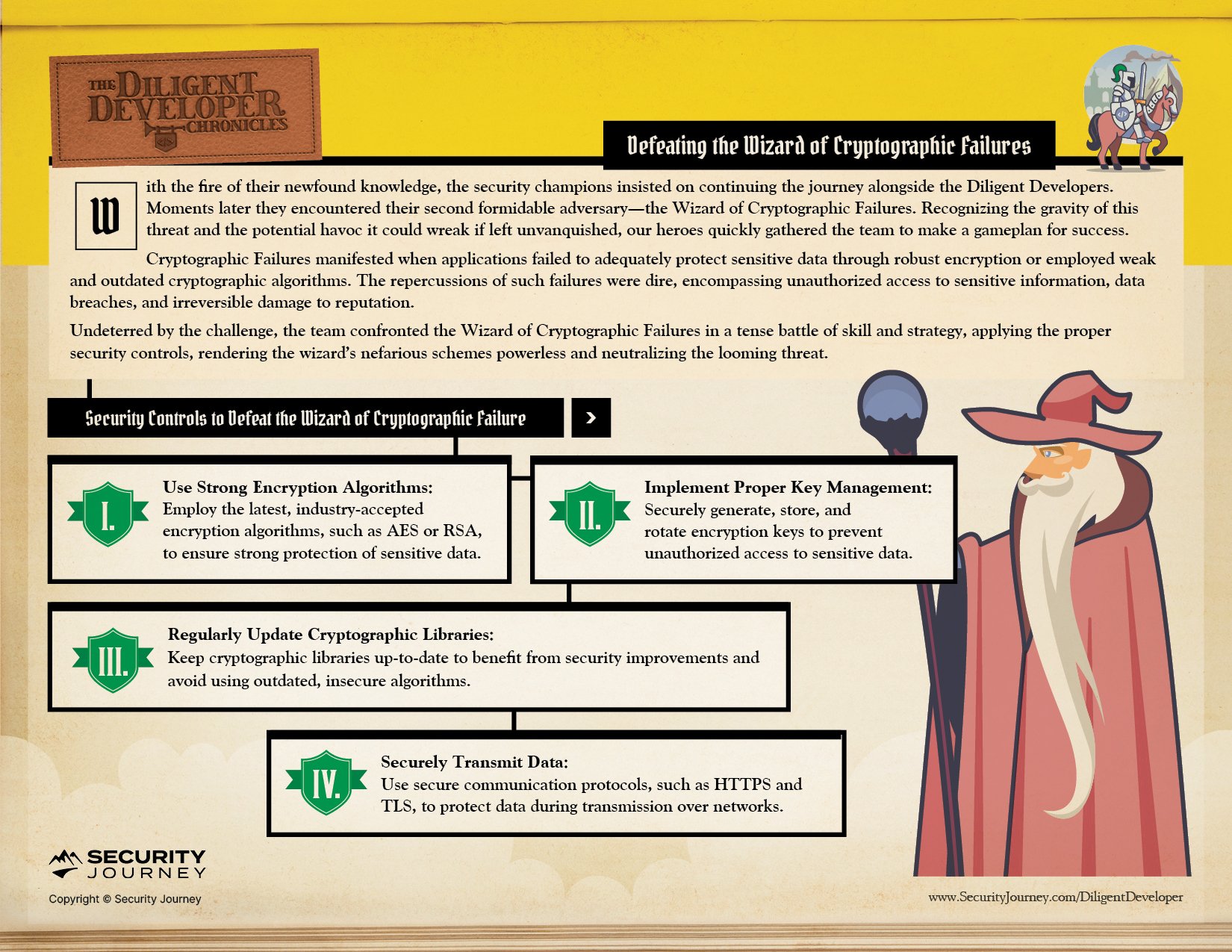Published on
The OWASP Top 10 is a valuable resource for the AppSec community, as it outlines the most prevalent vulnerabilities that developers must be aware of.
In this article, we will focus on Cryptographic Failures and advise how to prevent them in your code. We also recommend The Diligent Developer Chronicles as a helpful training resource for your development team.
Read More About OWASP Top 10: OWASP Top 10 Broken Access Control Explained
What are Cryptographic Failures?
OWASP Top 10 Cryptographic Failures are security vulnerabilities that can occur when cryptographic algorithms, protocols, or implementations are incorrectly used. This can expose sensitive data to attackers, such as passwords, credit card numbers, and personal identification numbers.
There are many different ways that cryptographic failures can occur. Some of the most common include:
Not Using Encryption
Sensitive data should always be encrypted when transmitted over the network or stored on a server.
Insecure Cryptographic Functions
Cryptographic functions can be implemented insecurely, leading to vulnerabilities.
Improper Key Management
Cryptographic keys are critical to the security of any system, so it's important to manage them properly.
Read More: OWASP: A02:2021 – Cryptographic Failures
Real-Life Example of a Cryptographic Failure: Exactis LLC.
Exactis is a marketing and data aggregation firm that collects and sells data on millions of people. In 2017, Exactis accidentally exposed a database containing 340 million individual records, including millions of US citizens' names, phone numbers, emails, and other sensitive data.
In the aftermath of the Exactis cryptographic failure, Exactis took steps to improve its data security to avoid sensitive data exposure and data breaches in the future. The company encrypted databases, secured servers, and implemented new security policies to protect data. Exactis also offered free credit monitoring to the people whose data was exposed to help monitor for identity theft and other issues.
Read the SecurityWeek Article: Massive Breach at Data Broker Exactis Exposes Millions of Americans
How Can You Protect Against Cryptographic Failures?
Cryptographic Failures allow attackers to access sensitive data that should be secure. Many things can be done to protect against cryptographic implementation errors and cryptographic vulnerabilities, but the key is to use secure encryption algorithms for cryptographic implementations.
Here are some ways you can prevent cryptographic weaknesses within your application:
Strong Encryption Algorithms
Embracing the latest, industry-accepted standards such as AES or RSA ensures robust protection of sensitive data against malicious actors.
Regularly Update Cryptographic Libraries
This practice enables you to benefit from the latest security enhancements and avoid using outdated and insecure algorithms.
Proper Key Management Procedures
Secure generation, storage, and rotation of encryption keys are paramount in preventing unauthorized access to sensitive data.
Secure Communication Protocols Such as HTTPS And TLS
These protocols safeguard data during transmission across networks.
Bring The Diligent Developers to Your Organization
Our AppSec experts at Security Journey recommend that developers don’t just take annual training on the latest OWASP Top 10 to stay aware of prominent vulnerabilities and code risks, but also have continuous training and conversations about secure coding practices in your organization to protect sensitive data.
But why not have fun in the process?
Security Journey developed The Diligent Developer Security Awareness & Education Program as a fun way to not only enhance security awareness, but to build skills across your development team to empower them to think securely and focus on data protection. This could be added to National Cybersecurity Awareness Month initiatives for the entire development team or be used to grow a security champions program.
In Chapter Two, The Diligent Developers take on The Wizard of Cryptographic Failures:
As The Diligent Developers continue on their journey, stay tuned to see what OWASP Top 10 Challenge they take on next.
Visit our webpage to learn more about accessing program materials and a program guide to train your organization on OWASP Top 10 vulnerabilities effectively.



